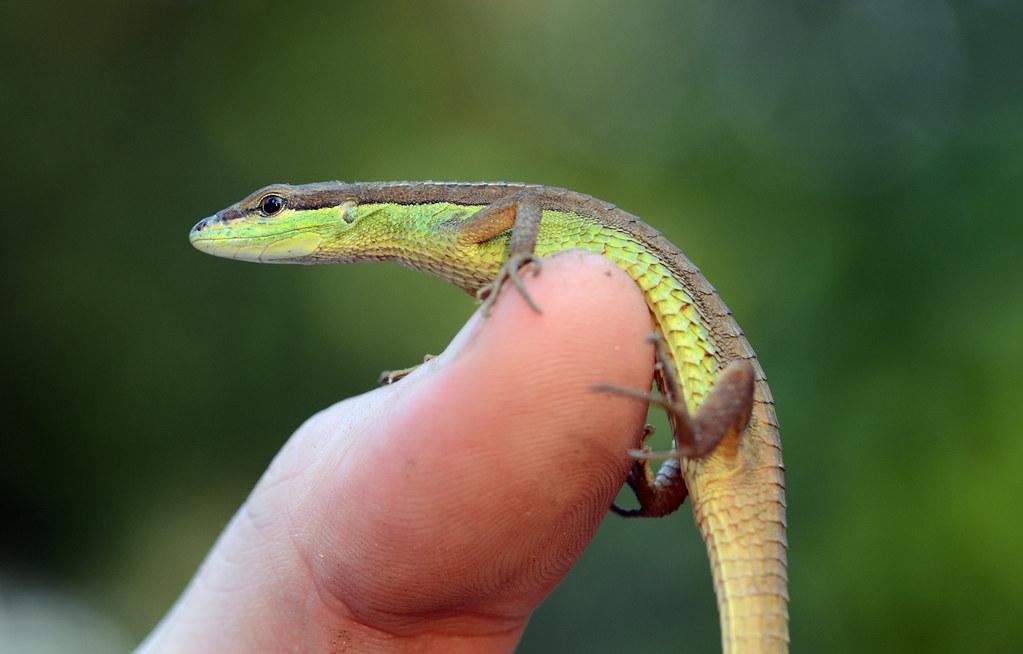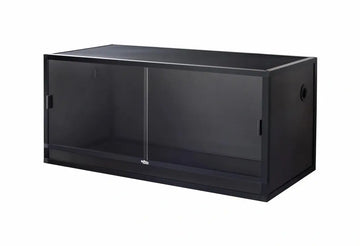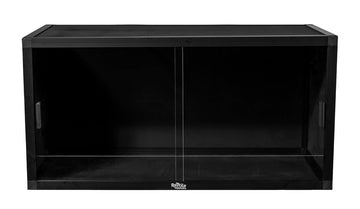The long-tailed grass lizard (Takydromus sexlineatus) is a 10-12” long, diurnal, terrestrial lizard native to southeast Asia. True to their name, they can typically be found living among tall grass in tropical areas.
Long-tailed grass lizards have very slender, streamlined bodies, and most of their length is actually tail, so they are smaller than their length implies. They typically have brown and green or brown and tan coloring, with a pattern of broad lateral stripes down the length of their body. The scales on their back and belly are rectangular and keeled, giving them a lightly armored appearance.
Long-tailed grass lizards are commonly sold in pet stores, but they have specific needs and aren’t exactly “easy” pet reptiles. However, with good care, they can be expected to live for at least 6 years.
Minimum terrarium size for long-tailed grass lizards
The absolute minimum terrarium size for a single long-tailed grass lizard is 30”L x 12”W x 12”H. Of course, larger is always better!
Although long-tailed grass lizards generally tend to get along when housed in the same terrarium, this will require more space. Housing multiple males together may result in fighting, and housing males and females together will result in eggs. Do not breed lizards unless you are fully prepared to accommodate the babies.
Do long-tailed grass lizards need UVB?
Yes! Long-tailed grass lizards require UVB lighting for their survival. UVB lighting helps provide a clear day/night cycle, provides all of the vitamin D that your pet needs, strengthens the immune system, facilitates better digestion, and other benefits.
The best UVB bulbs for long-tailed grass lizards housed in an 18-24” wide terrarium are:
- Zoo Med T8 Reptisun 10.0 — 3-4” above basking branch
- Arcadia T5 HO 6% — 4-6” above basking branch
For best results, house the UVB bulbs in a reflective fixture. Position the lamp on the same side of the terrarium as the heat lamp. UVB is blocked by glass and plastic, so placing the terrarium in front of a window doesn’t count as “free UVB” — in fact it can make your terrarium too hot due to the greenhouse effect. Don’t forget to replace your bulb every 12 months!
They are also likely to benefit from plant grow lights as part of their environment as well. Add a ~6500K LED or T5 HO fluorescent grow lamp to provide extra illumination, as well as help any live plants in the terrarium to thrive.
Lights should be on for 11.5 hours/day during winter and 12.5 hours/day during summer to simulate seasonal changes in day length. All lamps should be turned off at night.
Best temperature for long-tailed grass lizards
Long-tailed grass lizards should have a basking temperature of 90-95°F, as measured by a digital probe thermometer with the probe placed on the basking surface. In order to allow for proper thermoregulation, the enclosure should also have a cool area that stays between 75-85°F, also monitored by a probe thermometer. Nighttime temps can drop as low as 65°F.
Provide heat for your lizard with a halogen heat bulb. Halogen bulbs are the best way to imitate the warmth of sunlight indoors, and considered to be a superior form of reptile heating by experts. Do not use ceramic heat emitters (CHEs), red bulbs, or blue bulbs, as these are not as effective.
Best humidity levels for long-tailed grass lizards
Long-tailed grass lizards are a tropical species, so the humidity inside their enclosure should be fairly high: 70-80%. Humidity should be measured via digital probe hygrometer, with the probe placed in the middle of the terrarium.
Increase and maintain humidity by misting the enclosure 1-2x/day with a spray bottle. Mist first thing in the morning and then again at night if needed. Aside from raising humidity, this also provides your pet with an important source of drinking water!
Best substrate for long-tailed grass lizards
Providing a layer of naturalistic substrate (“bedding”) will help maintain correct humidity levels and also helps make your enclosure more attractive! We recommend the following substrates for long-tailed grass lizards:
Layering clean, chemical-free leaf litter on top of the substrate can also help with humidity.
Substrate should be at least 2” deep and completely replaced every 3-4 months. Remove poop and urates daily, along with contaminated substrate.
How to decorate a long-tailed grass lizard terrarium
An empty terrarium makes for a bored lizard, reducing its quality of life. Keep your pet entertained and engaged with its environment with the strategic use of décor items that encourage it to exercise natural behaviors!
Here are some items that your lizard is likely to put to good use:
- branches
- vines
- ledges
- live or artificial plants
Make sure to provide plenty of opportunity for your lizard to hide out of sight as needed. This helps it feel secure in its environment!
What to feed to a long-tailed grass lizard
Long-tailed grass lizards are insectivores, which means that they need to get the majority of their nutrition from insects, preferably live. Juveniles should be fed daily, while adults can be fed every other day. Offer as many insects as the lizard is capable of eating in about 5 minutes.
Feeder insects for long-tailed grass lizards: dubia roaches, discoid roaches, red runner roaches, crickets, black soldier fly larvae, hornworms, mealworms, flightless fruit flies
Supplements
You will also need calcium and vitamin supplements to help keep your pet healthy. We recommend Repashy Calcium Plus LoD, lightly dusted on all feeder insects. It’s okay to occasionally skip a dusting.
Water
Of course, don’t forget a small water bowl and feeding ledge for your pet to drink from! Change the water daily and scrub the bowl with a reptile-safe disinfectant weekly.
How to handle your long-tailed grass lizard
Long-tailed grass lizards are the type of pet that is best to leave alone rather than attempt to handle regularly. If you want to interact with your pet, try hand-feeding it with a pair of feeding tweezers.
*This care sheet contains only very basic information. Although it’s a good introduction, please further your research with high-quality sources. The more you know, the better you will be able to care for your pet!
"Long-tailed Grass Lizard, Takydromus sexlineatus Daudin, 1802" by Misenus1 is licensed under CC BY-NC-SA 2.0











